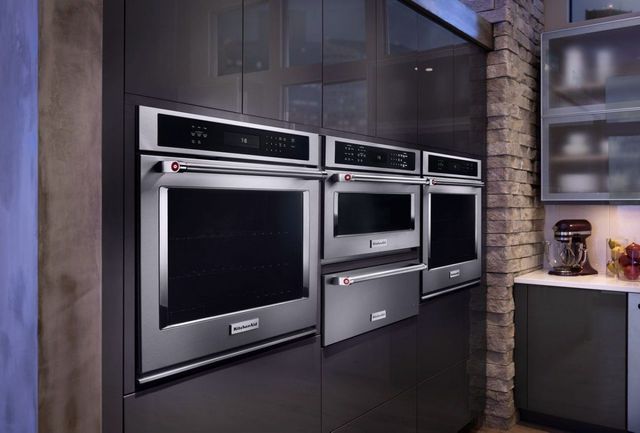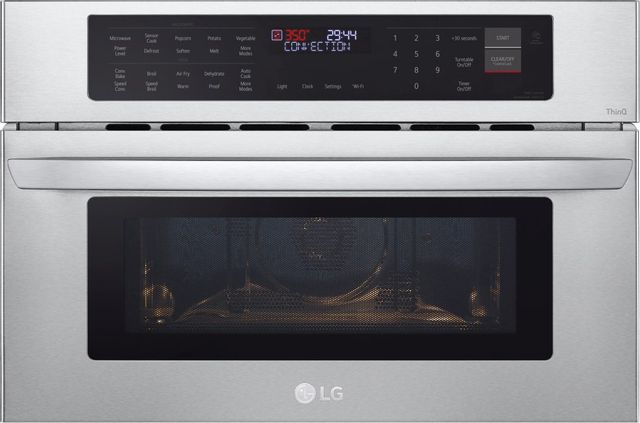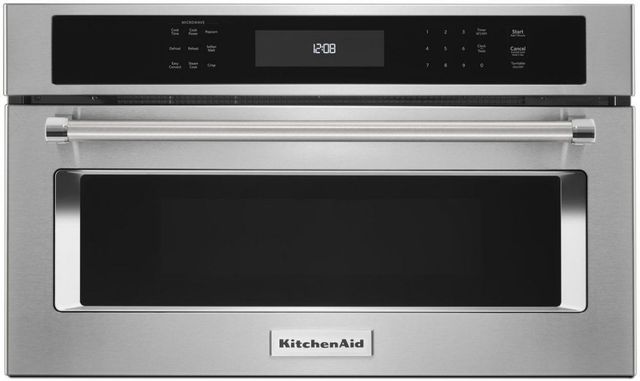
At a Glance:
What Are the Differences: Speed Oven vs Microwave
When it comes to cooking, having the right appliances can make all the difference. Two popular options for quick and easy are speed ovens and microwaves when it comes to heating food. But what sets these two appliances apart?
In this article, we will be discussing the key differences between these two popular kitchen appliances. We will go over the unique features and capabilities and the pros and cons of using a speed oven or a microwave.
Whether you are in the market for a new appliance or simply curious about the capabilities of these two, this Colder’s blog will provide the valuable information to make the right choice for you. So, let’s dive in and look at the speed oven vs. microwave debate.
Explore Cooking Appliance Deals
Discover speed ovens and microwaves from today’s best brands including LG and Maytag!
Cooking AppliancesWhat is a Speed Oven?
A speed oven is a combination of a traditional oven and a microwave. It uses convection heating and microwave technology to cook food quickly and evenly. Convection heating uses a fan to circulate hot air around the food, which helps to brown and crisp the surface of the food. At the same time, microwave technology heats food from the inside out, making for a delicious meal that tastes as good as it looks.

This combination of heating methods allows a speed oven to cook food faster than a traditional oven while still achieving the same level of browning and crisping. Additionally, speed ovens, like this LG speed oven, typically have a larger capacity and more cooking options than a microwave alone. They can be used for baking, roasting, broiling, and even grilling.
They also have a range of features like automatic cooking programs, temperature and time settings, and multiple racks, which can be used to cook different dishes simultaneously. It is an ideal appliance for those who have limited space in their kitchen and want to have the functionality of both oven and microwave in one appliance.
What is a Microwave?
A microwave is a type of kitchen appliance that uses microwaves — a type of electromagnetic energy, to heat food. The electromagnetic energy causes the food’s water molecules to vibrate, generating heat and cooking the food. Microwaves are popular for their convenience and speed, as they can cook or reheat food in a fraction of the time it would take using a traditional oven or stovetop.

Microwaves typically come in various sizes and styles, from small countertop models to larger built-in microwaves offered by KitchenAid. As a result, they can be used for a wide range of cooking tasks, including reheating leftovers, cooking frozen meals, making popcorn, and even baking cakes or bread. They also have different power levels and cooking settings, like defrost or express cook, to suit different dishes.
Microwaves are a convenient, time-saving appliance that can be a great addition to any kitchen. They are easy to use and clean. In addition, you can use them for cooking various dishes, making them a very versatile appliance.
What Are the Differences: Speed Oven vs Microwave
Speed ovens and microwaves are appliances used to quickly and easily heat food. Still, they have several key differences:
Cooking Method
Speed ovens use convection heating and microwave technology, while microwaves use only microwave electromagnetic energy to heat food. As a result, a speed oven can brown and crisp food, while a microwave cannot.
Convection heating uses a fan to circulate hot air around the food, which helps to brown and crisp the surface of the food. This gives the food a similar texture and taste as cooked in a traditional oven.
As a result of the water molecules in the food vibrating during the heating process in a microwave, the food is heated and cooked. Traditional ovens take longer to cook food than this method does. It can cook or reheat a variety of things, including popcorn, frozen meals, and leftovers.
But, combining both technologies in a speed oven allows cooking food faster than in a traditional oven while still achieving the same level of browning and crisping. This makes speed ovens a versatile and convenient option for those who want the functionality of a traditional oven and a microwave in one appliance.
Capacity and Size
Another critical difference between speed ovens and microwaves is their capacity and size. Speed ovens typically have a larger capacity than microwaves and are bigger. Some of them are designed to be built-in into the cabinets or walls, which means they can take up more space in the kitchen.
Microwaves, on the other hand, come in various sizes and styles, from small countertop models to larger built-in models. They can be easily placed on the countertop or built-in to save space.
Cooking Options
Speed ovens have built-in convection technology that allows you to cook various foods using different methods like baking, roasting, broiling, and grilling. This means you can use it for cooking a wide range of dishes such as lasagna, roasted chicken, grilled vegetables, and more.
On the other hand, microwaves are mainly used for reheating and cooking food quickly, such as leftovers, frozen meals, and popcorn. They also have defrosting options to defrost frozen foods quickly and evenly. They are not meant to be used for baking, roasting, broiling, and grilling.
Price
Price is another factor to consider when deciding between a speed oven and a microwave. Speed ovens are more expensive than microwaves because they have more advanced features and cooking options. A speed oven can cost anywhere from $800 to $3000, depending on the brand, model, and size. In contrast, microwaves can cost anywhere from $50 to $1000. Therefore, they are generally less expensive than speed ovens. Still, their price can vary depending on the brand, model, features, and size.
Pros and Cons of Speed Oven
A speed oven is a combination of a microwave and a traditional oven. Therefore, it has its own set of pros and cons. Some of the pros of a speed oven include the following:
- Faster Cooking: Speed ovens use convection technology to cook food faster than traditional ovens. This means you can cook a meal in less time, making it an excellent option for busy households.
- Multiple Cooking Options: Speed ovens offer a range of cooking options, including baking, roasting, broiling, and grilling, making them versatile appliances for a wide range of dishes.
- Even Cooking: The convection technology in speed ovens ensures that heat is distributed evenly, resulting in perfectly cooked food every time.
- Space-saving: Speed ovens can be built-in into the cabinets or walls, saving space in the kitchen.
- Energy Efficient: Speed ovens use less energy than traditional ovens, making them more energy-efficient.
Some of the cons of a speed oven include the following:
- Expensive: Speed ovens tend to be more expensive than microwaves because they have more advanced features and cooking options.
- Complex: Speed ovens can be more complex to use than microwaves, with multiple settings and options that can take time to learn.
- Limited Capacity: While speed ovens have a larger capacity than microwaves, they are still smaller than traditional ovens. This means they may not be suitable for cooking large dishes or for large families.
- Limited features: Some basic models may not have all the features you want, like a self-cleaning function or smart controls.
- Difficult to repair: Speed ovens are complex appliances with multiple functions and features, making them difficult and expensive to repair if something needs to be fixed.
Pros and Cons of Microwaves
A microwave is the standard appliance for heating up leftovers and preparing frozen meals. As a result, it has its own unique advantages and disadvantages. A microwave has some advantages, such as the following:
- Quick: Microwaves are designed to work quickly, making them an excellent option for busy households or people who want to prepare a meal quickly.
- Convenient: Microwaves are easy to use and can cook a wide range of dishes, including leftovers and frozen meals, and even lightly defrost certain foods.
- Affordable: Microwaves are generally less expensive than speed ovens, making them a cost-effective option for people on a budget.
- Space-saving: Microwaves are small and compact, making them an easy fit in small kitchens or apartments.
- Easy to repair: Microwaves are simple appliances with fewer features and functions, which makes them more accessible and less expensive to repair if something goes wrong.
Some of the cons of microwaves include the following:
- Limited cooking options: Microwaves are mainly used for reheating, cooking, and defrosting; they are not meant to be used for baking, roasting, broiling, and grilling like speed ovens.
- Uneven Cooking: Microwaves use microwaves to heat food, resulting in uneven cooking if the food is not properly rotated or stirred.
- Limited Capacity: Microwaves have a smaller capacity than speed ovens, so they may not be suitable for cooking large dishes or for large families.
- Safety Concerns: Microwaves can cause food to become overheated and dangerous if not used properly.
- Fire Hazard: Some food like metal, aluminum foils, or certain types of plastics are unsafe to be put in the microwave and could cause a fire or damage the appliance.
Choosing between a speed oven and a microwave is quite tricky — they are both great appliances. While speed ovens have a lot of advantages, they also have a higher price point and can take up more space than a microwave. So a speed oven might be the right choice if you are looking for a versatile appliance that can do a majority of the cooking you need done. But suppose you are looking for a more basic, cost-effective appliance mainly used for reheating and cooking. In that case, a microwave might be a better option.
Why Trust Colder’s?
Since 1942, we at Colder’s pride ourselves on offering value, selection, and service. Serving Southeastern Wisconsin with four showrooms that stock quality name-brand furniture, appliances, and mattresses, Colder’s is sure to house exactly what you are looking for. And if you can’t find it on our floors, chances are, we can order it for you. As a local, family-owned company, we are always doing our best to provide the highest value at the lowest cost to everyone who walks through our doors.
Colder’s is committed not only to continuously offering can’t-miss sales but also to working with each customer, making sure that you take advantage of every possible markdown — that’s our best price guarantee.
Shop Speed Ovens at Colder’s
Don’t put off happiness — and shop cooking appliances online for unbeatable prices at Colder’s. Our friendly experts are always happy to help you find your perfect speed oven, whether you call us at 414-476-1574 or use our online chat feature. Better yet, stop by one our Colder’s locations in West Allis, Oak Creek, Delafield, and Grafton, Wisconsin to touch, see, feel, and experience home products that fulfill your dreams. Visit us today!
Learn More: 6 Best Products from LG on the Market Now